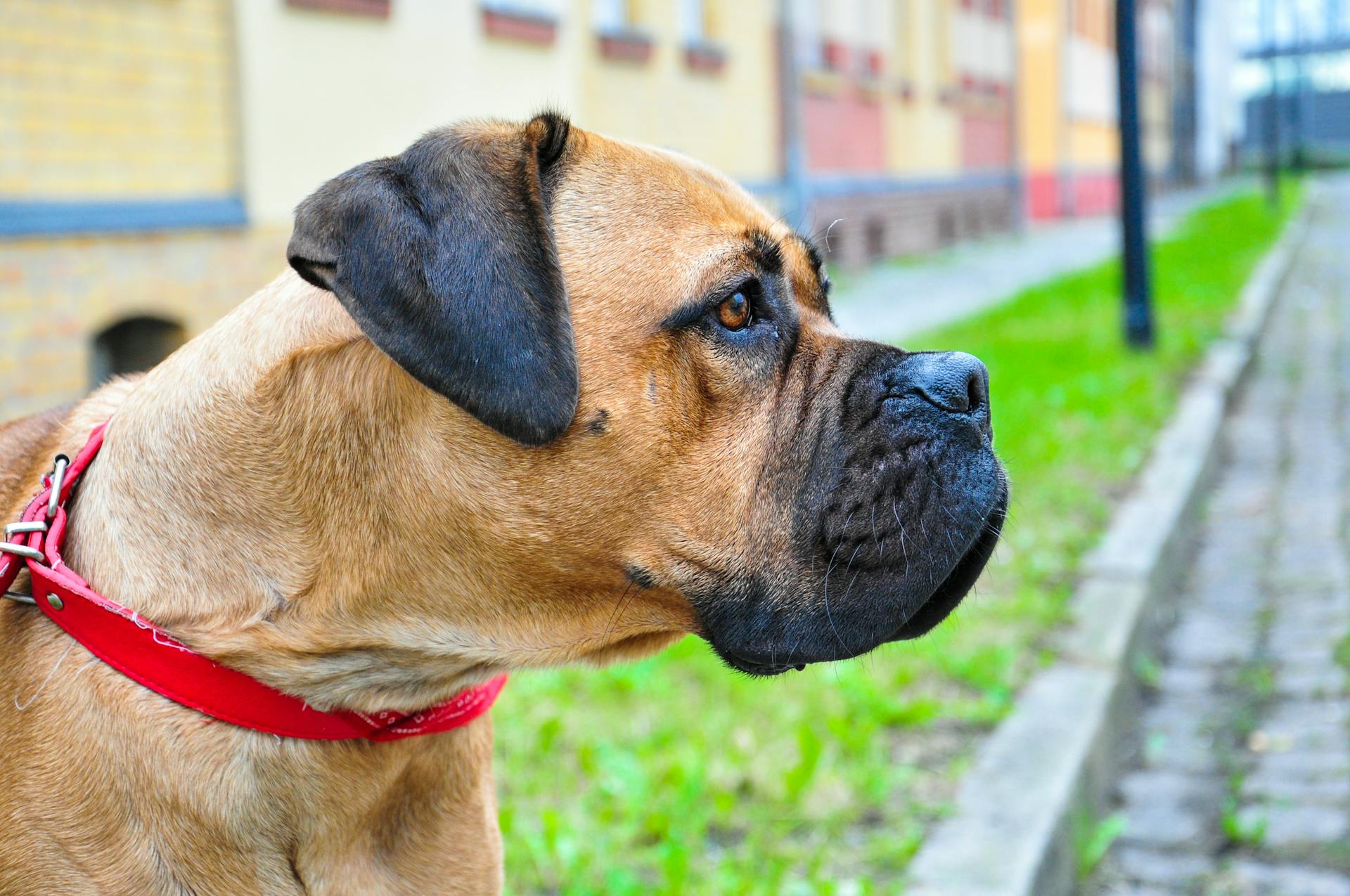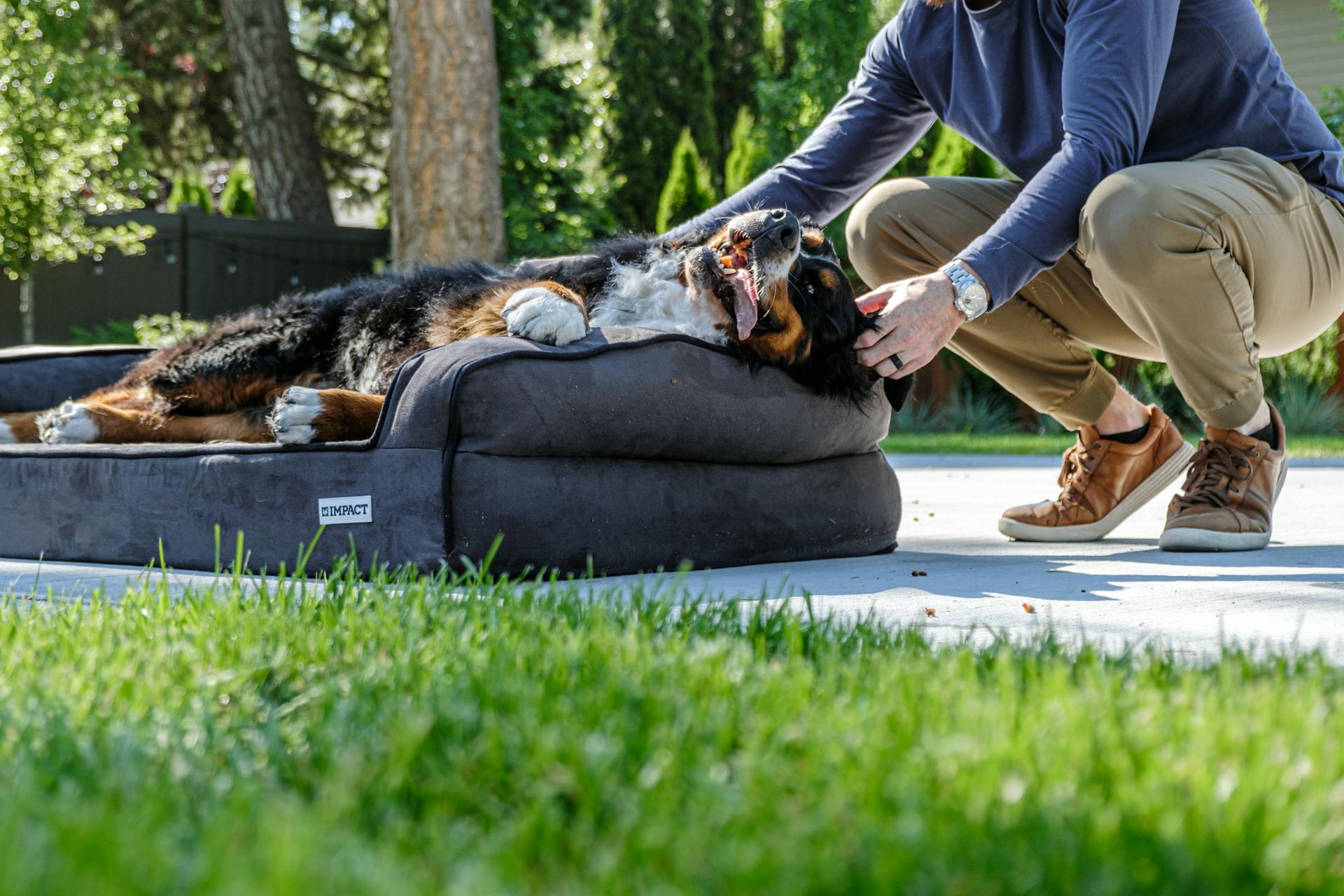
Raising a Bullmastiff mix can be a rewarding experience for the right owner. They are often loyal and gentle companions, but their size and strength require careful consideration.
Bullmastiff mixes typically weigh between 100 and 130 pounds and stand between 24 and 27 inches tall at the shoulder. This size makes them a significant investment in terms of space and resources.
Their short coats require minimal grooming, but regular nail trimming and ear cleaning are essential to prevent health issues. Regular exercise and mental stimulation are also crucial to prevent boredom and destructive behavior.
With proper care and attention, a Bullmastiff mix can live up to 8-12 years, making them a long-term companion for many families.
Care and Feeding
To keep your Bullmastiff mix happy and healthy, you'll want to establish a regular care routine. This includes feeding them a large- or giant-breed puppy formula until they're 18-24 months old, then transitioning to a large- or giant-breed adult formula.
Related reading: Wolf Dog Cross Breed
Feeding your Bullmastiff mix requires some special considerations to minimize the risk of bloat or GDV. This includes feeding them two or three meals a day instead of one, putting the food bowl on the floor rather than elevating it, and avoiding exercise from one hour before to one hour after a meal.
To ensure you're feeding the proper amount, follow the feeding guidelines on the dog food packaging and consult your veterinarian. They'll help you determine the ideal body weight and life stage of your Bullmastiff mix, and you can measure out the food for each meal accordingly.
A Bullmastiff mix will shed a little bit, especially during the spring and fall, but a quick brushing through the week will keep them looking neat and tidy. If they smell less-than-fresh, a bath is in order. Regular dental care, nail trimming, and ear checks will also keep them looking their best.
Here's a summary of the feeding guidelines:
- Feed large- or giant-breed puppy formula until 18-24 months old
- Transition to large- or giant-breed adult formula after 24 months
- Follow feeding guidelines on dog food packaging and consult your veterinarian
- Measure out food for each meal to ensure proper amount
Feeding Guidelines

When it comes to feeding your Bullmastiff, there are some essential guidelines to follow to ensure they stay healthy and happy.
Feed your Bullmastiff two or three meals a day instead of one to minimize the risk of bloat or GDV.
Their diet should be formulated for a large breed with medium energy, and their feeding needs will change from puppyhood to adulthood and into their senior years.
To determine the proper portion to feed your Bullmastiff, follow the feeding guidelines on the dog food packaging and consult your veterinarian.
Measure out the food for each meal to ensure you're feeding the right amount, and don't overfeed your Bullmastiff.
It's also a good idea to add some canned food to their dry food to make mealtime more interesting and varied.
To prevent dental issues and maintain good oral health, try to brush your Bullmastiff's teeth daily, especially if you start early when they're a puppy.

Here are some key feeding recommendations to keep in mind:
- Feed two or three meals a day
- Use a large- or giant-breed puppy formula until 18-24 months old, then transition to a large- or giant-breed adult formula
- Measure out food for each meal to ensure proper portion
- Add some canned food to dry food
- Brush teeth daily to prevent dental issues
Living Needs
Bullmastiffs need a secured, fenced area to exercise in, and should only be taken off-leash in their home environment. This is crucial to prevent them from getting into trouble or accidentally knocking people over with their strength.
They can thrive in apartment living if they get regular walks and time to sniff and explore outside. However, it's essential to monitor their exercise levels to avoid overworking their joints. A marathon partner, they are not.
Bullmastiffs aren't fond of hot and humid conditions, so make sure they have a cool place to rest. They should avoid overexerting themselves during exercise, especially in peak summer heat. Choose cool mornings or evenings for your walks instead.
If you're considering taking your Bullmastiff to a dog park, be aware that they have high prey drives. However, with proper supervision and socialization from an early age, they can do well around other dogs. Just remember to keep an eye on them and ensure they're comfortable around smaller breeds.
Here are some exercise tips to keep in mind:
Pet Care Considerations
Pet care considerations are crucial for the well-being of your Bullmastiff. Early training and socialization are essential to prevent unwanted behaviors.
Bullmastiffs are intelligent and learn quickly, but they require consistent training to become well-behited around people and other pets. They need to be trained to respond to specific commands, walk well on a leash, and remain calm in various situations.
A daily routine of exercise, including long walks and playtime in a fenced-in yard, is necessary to keep your Bullmastiff happy and healthy. They don't make good running companions due to their lack of stamina.
Feeding your Bullmastiff the right food is also vital. Large-breed puppy food should be fed to help protect their joints, and a balanced diet can prevent digestive issues.
Regular veterinary check-ups are necessary to detect any health concerns early. Your vet can help you develop a care routine that will keep your dog healthy.
Here's a quick rundown of your Bullmastiff's needs:
Remember, patience and consistency are key when caring for your Bullmastiff. With the right care and attention, they can become loving and loyal companions.
Health and Wellness
Bullmastiff mixes are indeed a lot to love, but their health can be a concern. Their average lifespan is 7-9 years, which is relatively short compared to smaller breeds.
As a large dog, your bullmastiff mix is susceptible to bloat, a condition that can be deadly if not treated immediately. Knowing the signs of bloat is crucial, and it's essential to seek veterinary attention right away if you notice any symptoms.
Preventing bloat is also important, and one way to do this is by tacking your dog's stomach as a preventative measure. This can be a lifesaver in case of an emergency.
Your bullmastiff mix may also be prone to certain health issues, including heart conditions, hypothyroidism, and progressive retinal atrophy. Regular veterinary checkups can help identify these issues early on.
Elbow and hip dysplasia are also common health problems in bullmastiffs, which can be painful and degenerative. This condition is usually hereditary, so it's essential to consult with a veterinarian about genetic factors and exercise recommendations.
For your interest: Bullmastiff Health Issues
Here's a list of potential health issues your bullmastiff mix may face:
- Entropian Eye
- Hip Dysplasia
- Elbow Dysplasia
- Cataracts
- Progressive Retinal Atrophy
- Luxating Patellas
- Gastric Dilation Volvulus
It's essential to be aware of these potential health issues and take steps to prevent them. Regular veterinary care, a healthy diet, and plenty of exercise can go a long way in keeping your bullmastiff mix happy and healthy.
Personality and Temperament
Bullmastiffs have a kind temperament around family members, including children, but can become suspicious of new people in their home, making socialization during puppyhood critical.
They are very smart and learn quickly, doing well in socialization classes, puppy training classes, and obedience training.
Bullmastiffs are peaceful cuddle bugs who crave human company and will often want to be in the same room with you, or even on your lap.
They can be lazy, yet alert and playful, and require regular, moderate exercise to stay healthy and prevent obesity.
Early socialization and training are crucial to ensure a well-behaved pet, as they can be stubborn and headstrong.
Suggestion: Bullmastiff Training
Their gentle and protective nature makes them excellent family companions, but they need consistent, patient training and positive reinforcement methods.
They are generally good with children and other pets, especially when properly socialized from a young age.
Their intelligence and natural abilities can be tapped into with agility sports and tracking games, or by training them as therapy dogs.
Appearance
A bullmastiff's appearance is a great reflection of their personality - they exude confidence and strength. Their large head is held high, and their focused gaze makes them look like they're always ready to take on a challenge.
Their sturdy legs support a deep chest and broad shoulders, giving them a square, muscled body that's perfect for a working dog. They're not as sad-looking as you might think, despite their wrinkles and folds.
Their coat is sleek, dense, and short, usually fawn or red with black accents around their eyes and ears. Males weigh between 110-130 pounds, and females range from 100-120 pounds.
Their size is impressive, standing at 27 inches at the withers, which is pretty common for this large breed.
Personality and Temperament
Bullmastiffs are kind and gentle with family members, including children, but can be suspicious of new people, making socialization crucial.
They have lots of energy and require training from an early age, which is good news because they're highly intelligent and learn quickly.
Bullmastiffs can get along with other pets, but socialization with them must start early.
They're peaceful cuddle bugs who crave human company and will often want to be near you, but they need proper no-fear and positive reinforcement training to become their best selves.
This training should start when they're about 10 weeks old and after their vaccinations are complete.
Bullmastiffs are more than 100 pounds of canine energy, requiring loving but firm guidance to control.
Their training shouldn't stop with puppy kindergarten and socialization training; regular refresher courses are essential to keep them on track.
Socialization is key to helping your bullmastiff see new people, animals, and situations as good things.
They can have a hard time with "no" sometimes meaning "maybe", so being inconsistent can set them and the family up for unfair expectations.
Bullmastiffs don't need daily intense exercise to stay healthy and happy, but regular walks and praise reinforcement of good habits will keep them content.
They're relatively quiet hounds who don't bark much and are known to be gentle giants, but they have a strong watchdog instinct and will alert you if they sense something's amiss.
Doubull Mastiff
The Doubull Mastiff is a gentle giant that can weigh up to 200 pounds.
They have a straight coat that doesn't shed much, making them a great choice for people with allergies or who prefer less dog hair.
Getting them to go for long walks can be a struggle due to their laziness.
Grooming Guide
Bullmastiff mixes are known for their short, coarse fur that sheds seasonally.
A monthly brushing is all this breed needs to stay looking neat and tidy, especially during the spring and fall when shedding is more prominent.
They won't need a professional groomer and their short fur isn't prone to matting, making it a low-maintenance coat.
Bullmastiffs are notorious for their moderately drooly jowls, so you might find yourself wiping drool from your floor and furniture as part of your cleaning routine.
To keep their mask folds clean, a veterinarian can advise on the best methods.
A quick brushing through the week will help keep your bullmastiff mix looking neat and tidy, and if they smell less-than-fresh, a bath is in order.
Don't forget to trim their nails before they get too long – usually once or twice per month – to prevent clicking against the floor.
Daily ear checks and cleaning, as recommended by your vet, will also keep your bullmastiff mix looking spiffy.
Training and Behavior
Bullmastiff mixes are intelligent dogs that can excel in a variety of training classes, including puppy classes, obedience, and agility.
They can become calm and well-mannered dogs if trained properly from a young age.
Training must be started when a Bullmastiff mix is young, because they can become stubborn and difficult to train as they mature.
Exercise Needs
Bullmastiffs need regular exercise, but it's not about being a marathon partner - they can work out too much, especially when they're young and still growing.
A secured, fenced area is a must for exercise, and they shouldn't be taken off-leash except in their home environment.
They can do well as apartment dwellers if they're taken outside for regular strolls and sniffing sessions.
Nice, long walks will suit them just fine, but it's essential to avoid hot and humid conditions, especially during summer heat.
Choose cool mornings or evenings for your walks to keep them comfortable.
Bullmastiffs have high prey drives, but with proper supervision and socialization from an early age, they should do well around other dogs.
Training
Training is crucial for Bullmastiffs, especially when they're young. They're intelligent dogs that can quickly learn during training classes.
To get the best out of your Bullmastiff, start training as early as possible. Bullmastiffs can become stubborn and difficult to train as they mature.
Bullmastiffs can excel in various training classes, including puppy classes, obedience, and agility.
Rescue Groups
Finding a rescue group for a Bullmastiff mix can be a bit tricky, but it's not impossible. There may not be a breed-specific rescue for Bullmastiff mixes, but you can try contacting Staffordshire Bull Terrier or Bullmastiff breed-specific rescues, as they often care for mixes as well.
Some rescues you can try include Little Angels Staffie Rescue (LASR) and Mid-America Bully Breed Rescue (MABBR), which have experience with Bullmastiff mixes.
Take a look at this: Red Heeler Mixes
General Information
Bullmastiff mix breeds are generally large to giant-sized dogs, inheriting the size characteristics of the Mastiff parent.
They can be loyal, protective, and gentle, making them great family dogs, but early socialization and training are crucial to ensure a well-behaved pet.
Mastiff mix breeds typically require regular, moderate exercise to keep them healthy and prevent obesity, with daily walks, playtime, and mental stimulation being important for their well-being.
Their gentle and protective nature can make them excellent family companions, especially when properly socialized from a young age.
A unique perspective: Wolfdog Breeds
Regular brushing, nail trimming, and ear cleaning are important for maintaining the overall health and hygiene of Bullmastiff mix breeds, depending on the coat type inherited from the non-Mastiff parent.
Like purebred Mastiffs, Bullmastiff mix breeds may be prone to certain health issues, such as hip dysplasia and heart conditions, so regular veterinary check-ups and a healthy diet are essential for their well-being.
For more insights, see: Chocolate Lab Mix Breeds
History
Bullmastiffs have a rich history that dates back to the mid-1880s in England, where they were bred to help gamekeepers protect their estates from poachers.
Their original purpose was to be a quick and assertive dog that could track poachers with stealth and run fast to pin them down until the gamekeeper arrived.
The breed was created by breeding mastiffs and bulldogs together, resulting in an imposing animal with a unique combination of traits.
These early bullmastiffs were soon introduced to the British competition circuit, where they impressed judges with their impressive presence and formidable abilities.

The breed gained popularity in the early 1900s, and breed fanciers pushed for recognition with England's Kennel Club, which was granted in 1924.
Bullmastiffs were later imported to the US in the 1920s by oil magnate John D. Rockefeller, who wanted to add them to his country estate in the Hudson River Valley of New York.
The American Kennel Club recognized purebred bullmastiffs in 1933, cementing their place as a recognized breed.
Additional reading: Half Wolf Half Husky Breed
Dog Breed
Mastiff mix breeds are a unique combination of traits and characteristics from their parent breeds. They can inherit the size characteristics of the Mastiff parent, making them large to giant-sized dogs.
The temperament of Mastiff mix breeds can vary, but they often inherit a mix of temperaments from their parent breeds. They can be loyal, protective, and gentle, making them great family dogs.
Bullmastiffs, in particular, are known for their calm temperament and are not typically anxious or fearful. However, they can be very protective of their home and family.
Take a look at this: Bullmastiff Personality
Mastiff mix breeds can be good with children and other pets, especially when properly socialized from a young age. This is because they tend to be gentle and protective of their family.
Here are some common Mastiff mix breeds:
- Mastiff Lab mix (Mastador)
- Mastiff Bulldog mix (Bullmastiff)
- Mastiff Boxer mix (Boxmas)
- Mastiff German Shepherd mix (Shepiff)
Regular exercise is essential for Mastiff mix breeds to keep them healthy and prevent obesity. Daily walks, playtime, and mental stimulation are important for their well-being.
Bullmastiffs are extremely intelligent and usually learn quickly during training. However, early training and socialization are crucial to prevent unwanted behaviors.
Frequently Asked Questions
What is the best Mastiff mix?
The Mastiff Golden Retriever Mix is a popular and energetic breed, known for its friendly temperament. This mix is a great choice for active families who want a loyal and loving companion.
What are bullmastiffs mixed with?
Bullmastiffs are a cross between Bulldogs and Mastiffs, bred for their unique guarding abilities. This mix of breeds created a powerful and loyal companion.
How big do Bullmastiff mix get?
Bullmastiff mixes can grow up to 160 pounds and require ample space to move around. They're not ideal for apartment living due to their large size.
How big can a Bullmastiff get?
A Bullmastiff typically weighs between 100-130 pounds and stands 25-27 inches tall, with males generally being larger than females.
What is the lifespan of a Mastiff mix dog?
The lifespan of a Mastiff mix dog typically ranges from 7 to 10 years, influenced by the individual breed differences and life expectancies of its parent breeds. Consult a veterinarian for a more accurate estimate based on your dog's specific characteristics and health.
Featured Images: pexels.com